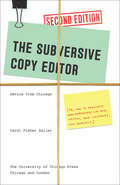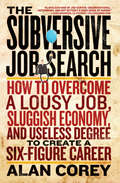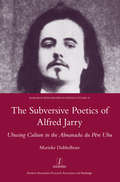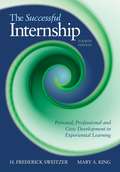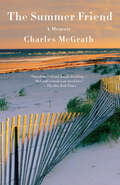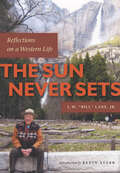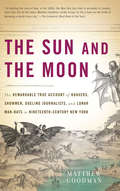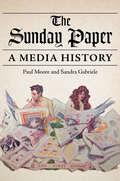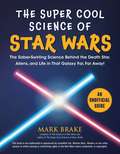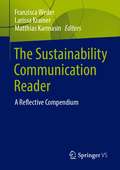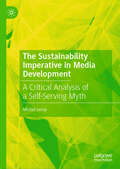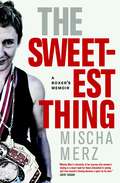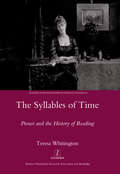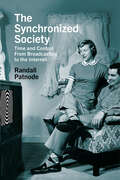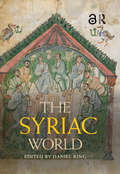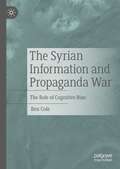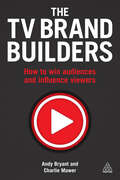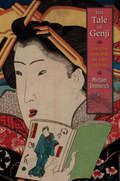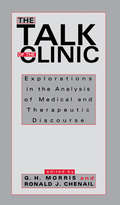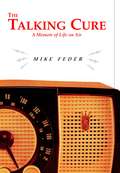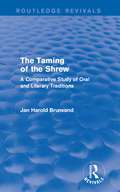- Table View
- List View
The Subtle Subtext: Hidden Meanings in Literature and Life
by Laurent PernotSubtexts are all around us. In conversation, business transactions, politics, literature, philosophy, and even love, the art of expressing more than what is explicitly said allows us to live and move in the world. But rarely do we reflect on this subterranean dimension of communication.In this book, renowned classicist and scholar of rhetoric Laurent Pernot explores the fascinating world of subtext. Of the two meanings present in any instance of double meaning, Pernot focuses on the meaning that is unstated—the meaning that counts. He analyzes subtext in all its multifarious forms, including allusion, allegory, insinuation, figured speech, irony, innuendo, esoteric teaching, reading between the lines, ambiguity, and beyond. Drawing on examples from figures as varied as Homer, Shakespeare, Molière, Proust, Foucault, and others, as well as from popular culture, Pernot shows how subtext can be identified and deciphered as well as how prevalent and essential it is in human life.With erudition and wit, Pernot explains and clarifies a device of language that we use and understand every day without even realizing it. The Subtle Subtext is a book for anyone who is interested in language, literature, hidden meanings, and the finer points of social relations.
The Subtle Subtext: Hidden Meanings in Literature and Life
by Laurent PernotSubtexts are all around us. In conversation, business transactions, politics, literature, philosophy, and even love, the art of expressing more than what is explicitly said allows us to live and move in the world. But rarely do we reflect on this subterranean dimension of communication.In this book, renowned classicist and scholar of rhetoric Laurent Pernot explores the fascinating world of subtext. Of the two meanings present in any instance of double meaning, Pernot focuses on the meaning that is unstated—the meaning that counts. He analyzes subtext in all its multifarious forms, including allusion, allegory, insinuation, figured speech, irony, innuendo, esoteric teaching, reading between the lines, ambiguity, and beyond. Drawing on examples from figures as varied as Homer, Shakespeare, Molière, Proust, Foucault, and others, as well as from popular culture, Pernot shows how subtext can be identified and deciphered as well as how prevalent and essential it is in human life.With erudition and wit, Pernot explains and clarifies a device of language that we use and understand every day without even realizing it. The Subtle Subtext is a book for anyone who is interested in language, literature, hidden meanings, and the finer points of social relations.
The Subversive Copy Editor, Second Edition: Advice from Chicago (or, How to Negotiate Good Relationships with Your Writers, Your Colleagues, and Yourself)
by Carol Fisher SallerLongtime manuscript editor and Chicago Manual of Style guru Carol Fisher Saller has negotiated many a standoff between a writer and editor refusing to compromise on the "rights" and "wrongs" of prose styling. Saller realized that when these sides squared off, it was often the reader who lost. In her search for practical strategies for keeping the peace, The Subversive Copy Editor was born. Saller's ideas struck a chord, and the little book with big advice quickly became a must-have reference for copy editors everywhere. In this second edition, Saller adds new chapters, on the dangers of allegiance to outdated grammar and style rules and on ways to stay current in language and technology. She expands her advice for writers on formatting manuscripts for publication, on self-editing, and on how not to be "difficult." Saller's own gaffes provide firsthand (and sometimes humorous) examples of exactly what not to do. The revised content reflects today's publishing practices while retaining the self-deprecating tone and sharp humor that helped make the first edition so popular. Saller maintains that through carefulness, transparency, and flexibility, editors can build trust and cooperation with writers. The Subversive Copy Editor brings a refreshingly levelheaded approach to the classic battle between writers and editors. This sage advice will prove useful and entertaining to anyone charged with the sometimes perilous task of improving the writing of others.
The Subversive Job Search
by Alan CoreyAre you tired of missing out on that raise, bonus, or promotion? Do you want to turn your dead-end job into a high-paying career? Would a six-figure salary solve all your problems? Moneymaking guru Alan Corey faced all these questions himself, then went from collecting unemployment checks to bringing in a six-figure salary in just over a year. This inspirational and entertaining book is jam-packed with easy-to-follow steps that you can use to transform your own career. Alan couples his personal anecdotes with scientific studies that are guaranteed to increase your salary. The Subversive Job Search will help steer you into the $100,000-plus career you've been waiting for. Are you frustrated because . . . · Your coworkers make more than you? · Your boss is unreasonable and doesn't appreciate you? · Your paychecks aren't making ends meet? · Your stagnant career is going nowhere fast? It's easier than you think to get paid like an expert. If Alan Corey can do it, so can you!
The Subversive Poetics of Alfred Jarry: Ubusing Culture in the Almanachs Du Pere Ubu
by Marieke DubbelboerParadox and provocation were essential features of all of the work of Alfred Jarry (1873-1907). His non-conformist attitude, whether employed to subvert literary or artistic conventions or to scrutinize social and political issues, marked both his literary writing and his view of the world. Nowhere is this more apparent than in the experimental and satirical Almanachs du Pere Ubu (1898 and 1901), which to date have received little critical attention. Jarry's groundbreaking use of collage in these early works, his absurdist humour and his rethinking of literary authorship and artistic originality foreshadow many innovations of twentieth-century art and literature. In this generously illustrated study Marieke Dubbelboer examines key characteristics of Jarry's poetics through an analysis of the Almanachs and addresses their role within the European avant-garde.
The Successful Internship: Personal, Professional, and Civic Development in Experiential Learning (Fourth Edition)
by H. Frederick Sweitzer Mary A. KingThe Successful Internship: Personal, Professional, and Civic Development in Experiential Learning (Fourth Edition) offers you more than just a resource for how to find a position or how to interview. It addresses the concerns, emotions, needs, and unique personal challenges that are the essence of an internship or field experience, and focuses on the internship as a vehicle for your development as a civic professional. The authors describe in detail the path of change you'll find yourself embarking on and the challenges you'll face along the way. A four-stage model of the internship process--anticipation, exploration, competence, and culmination--places the material in a meaningful framework that lends structure to your understanding of the work you'll be doing. Available with InfoTrac Student Collections http://gocengage.com/infotrac.
The Summer Friend: A Memoir
by Charles McGrathAlive with the intoxicating magic of summer in New England, former editor of the New York Times Book Review Charles McGrath&’s evocative memoir looks back at that sun-soaked season, at family, youth, and a singular bond made at a time when he thought he was beyond making friends. &“To read Chip McGrath&’s gentle, elegant memoir … is to lose yourself in your own past summers, especially the ones of your youth, when you imagined there&’d be an infinite number of them, and also friends to share those summers with. That both turn out to be numbered makes this book positively ache with beauty and loss.&” —Richard RussoIt was early evening and a new acquaintance had come to retrieve his daughter from a play date. Instead of driving up in a minivan, he arrived by water, tacking his sailboat smartly across a squiggly channel in the marsh, throwing a rope overboard, and zipping back home, his gleeful daughter riding in the wake. Who knew you could do such a thing? And how could you resist befriending a man such as that? Over the course of this rich memoir, McGrath recalls with a gimlet eye the pleasures of summers past: amateur lobstering, 9-hole golf, family costume charades, bridge-jumping, and a friendship forged between two men from different backgrounds who came together late in life. Recounting the vagaries of summer with such precision and warmth-- peeling long strips of sunburnt skin from your shoulder as if &“shuffling off your own cocoon,&” the outdoor shower curtain blowing open in the breeze, an M80 firework in the mailbox--The Summer Friend is simultaneously a potent evocation of the rhythms and rituals of summer and a stirring remembrance of a friend found and then lost.
The Sun Never Sets: Reflections on a Western Life
by L. W. Bill" Lane Jr.The Sun Never Sets tells the extraordinary story of L.W. "Bill" Lane, Jr., longtime publisher of Sunset magazine, pioneering environmentalist, and U.S. ambassador. Written with Stanford historian Bertrand Patenaude, this fascinating memoir traces Sunset's profound impact on a new generation of Americans seeking opportunity and adventure in the great American West. Bill Lane was a Californian whose life spanned a vital period of the state's emergence as the embodiment (or symbol) of the country's aspirations. His recollections offer readers a rich slice of the history of California and the West in the 20th century. Recounting his boyhood move from Iowa to California after his father purchased Sunset magazine in 1928, and his subsequent rise through the ranks of Sunset, Bill Lane's memoir evokes the American West that his magazine helped to shape. It illuminates the sources of Sunset's canny appeal and its manifold influence in the four major editorial fields it covered--travel, home, gardening, and cooking--while taking readers behind the scenes of American magazine publishing in the 20th century. The Sun Never Sets also reveals the evolution of Bill Lane's views and roles as an influential environmentalist and conservationist with strong connections to the national and California state parks, and it recounts his two stints as U.S. ambassador: in Japan in the 1970s, and in Australia in the 1980s. This memoir will especially appeal to readers interested in the history of the American West, environmental conservation and preservation, and publishing.
The Sun and the Moon: The Remarkable True Account of Hoaxers, Showmen, Dueling Journalists, and Lunar Man-Bats in Nineteen
by Matthew GoodmanOn August 26, 1835, a fledgling newspaper called the Sun brought to New York the first accounts of remarkable lunar discoveries. A series of six articles reported the existence of life on the moon--including unicorns, beavers that walked on their hind legs, and four-foot-tall flying man-bats. In a matter of weeks it was the most broadly circulated newspaper story of the era, and the Sun, a working-class upstart, became the most widely read paper in the world. An exhilarating narrative history of a divided city on the cusp of greatness, and tale of a crew of writers, editors, and charlatans who stumbled on a new kind of journalism, The Sun and the Moon tells the surprisingly true story of the penny papers that made America a nation of newspaper readers.
The Sunday Paper: A Media History (The History of Media and Communication)
by Paul Moore Sandra GabrielePullout sections, poster supplements, contests, puzzles, and the funny pages--the Sunday newspaper once delivered a parade of information, entertainment, and spectacle for just a few pennies each weekend. Paul Moore and Sandra Gabriele return to an era of experimentation in early twentieth-century news publishing to chart how the Sunday paper became an essential part of American leisure. Transcending the constraints of newsprint while facing competition from other media, Sunday editions borrowed forms from and eventually partnered with magazines, film, and radio, inviting people to not only read but watch and listen. This drive for mass circulation transformed metropolitan news reading into a national pastime, a change that encouraged newspapers to bundle Sunday supplements into a panorama of popular culture that offered something for everyone.
The Super Cool Science of Harry Potter: The Spell-Binding Science Behind the Magic, Creatures, Witches, and Wizards of the Potter Universe!
by Mark BrakeDiscover the scientific secrets of Harry, Hermione, Ron, Dumbledore, and more in J. K. Rowling&’s universe.Movie-goers and young readers the world over have been spellbound by the tales of &“the boy who lived.&” J. K. Rowling&’s stories have conjured ideas of magic and sorcery into our minds like no other book series before. But nature is its own magic. And Muggle scientists have uncovered answers for the weird and wonderful questions from the magic world. Questions such as: Who was the real Merlin?Who really was the last great wizard?Do real-life love potions work?Platform 9¾: are there real hidden railway stations in London?And many more!The Super Cool Science of Harry Potter is for any young fan of Harry Potter. You don&’t need to be a witch or wizard to weave your magical way through the facts about your favorite characters, potions, spells, and mysteries from the boy wizard&’s world!
The Super Cool Science of Star Wars: The Saber-Swirling Science Behind the Death Star, Aliens, and Life in That Galaxy Far, Far Away!
by Mark BrakeLearn about the science used by Luke Skywalker, Kylo Ren, Han Solo, Chewbacca, Princess Leia, and more in the Star Wars galaxy.Star Wars has captured the hearts and imaginations of sci-fi fans worldwide. We all marvel at its dazzling variety of aliens, spaceships, and planets. That&’s because there&’s something revolutionary about the actual science in Star Wars. These painted pictures from the movies make us see the universe in a new light. They inspire us to ask questions such as:How much would it cost to build a Death Star?Did Star Wars predict the existence of exoplanets?Could a single blast from the Death Star destroy the earth?Could Starkiller Base suck the energy from a star?And many more!The Super Cool Science of Star Wars is a book for any young Star Wars fan. You don&’t need to be a Jedi scientist to make the jump to light speed and find the facts behind the Star Wars galaxy!
The Sustainability Communication Reader: A Reflective Compendium
by Larissa Krainer Matthias Karmasin Franzisca WederThe Textbook seeks for an innovative approach to Sustainability Communication as transdisciplinary area of research. Following the United Nations Sustainable Development Goals, which are intended to transform the world as it is known, we seek for a multidisciplinary discussion of the role communication plays in realizing these goals. With complementing theoretical approaches and concepts, the book offers various perspectives on communication practices and strategies on an individual, organizational, institutional, as well as public level that contribute, enable (or hinder) sustainable development. Presented case studies show methodological as well as issue specific challenges in sustainability communication. Therefore, the book introduces and promotes innovative methods for this specific area of research.
The Sustainability Imperative in Media Development: A Critical Analysis of a Self-Serving Myth
by Michel LeroyThis book critically examines how the media assistance and broader 'development' sector have appropriated the catch-all concept of sustainability, originally rooted in economic and environmental fields, to suit their agendas. Analysing 289 project evaluations conducted globally between 1999 and 2019, it scrutinizes the tacit discourses underpinning what Bourdieu termed “the imperialism of the universal” in fostering media systems in the global South. The book reveals how processes of self-legitimation operate within an increasingly competitive aid market, highlighting a shift from ‘post-missionary’ approaches to business-driven models. Focusing on the often-overlooked African context, it explores nuanced coping capacity in Uganda and the Eastern DRC. Amid questioning of the populist wave as well as power-motivated new entrants, it challenges the recurring aid pattern, emphasizing the urgency of centering social impact and values in media assistance. It offers essential insights for scholars and practitioners navigating the evolving geopolitics of development and public diplomacy.
The Sweetest Thing: A Boxer's Memoir
by Mischa MerzJournalist and amateur boxer Mischa Merz fulfills a long-held ambition to travel across the United States and compete in a series of amateur boxing tournaments. On this wild and fascinating journey she meets her idols, including Lucia Rijker of Million Dollar Baby fame, and some other truly extraordinary characters. Merz discovers the horrors and delights of the world of women's boxing and gains insights into this eccentric subculture's place in American life. She also meets some of the pioneers and trailblazers of the contemporary rise in women's boxing as well as some of the younger stars now hoping to make it onto the first women's boxing team in the 2012 Olympic Games.Written in a compelling and highly entertaining narrative style, Mischa Merz takes us right into the ring and reports, with a rare insider's view, on a sport that has for centuries defined our ideas about masculinity.
The Syllables of Time: Proust and the History of Reading
by Teresa WhitingtonThis study reveals reading to be one of the main activities to occupy the inhabitants of the world of Marcel Prousts novel A la recherche du temps perdu. Characters do not just read books but have access to the journals and newspapers of a rapidly expanding print industry. They receive letters and postcards from family and friends. The posters of a nascent advertising industry tempt them to spend an evening at the theatre or a holiday by the sea, and new forms of communication, such as telegraphy, enter their lives and require new strategies of deciphering. All human activity is glossed by means of a series of metaphors of reading, extending the readers domain beyond the written text. Through a series of illuminating analyses, Teresa Whitington shows how this web of references builds into a specifically Proustian account of both the outer, social context of reading and the inner, psychological world of the reader. Proust offers a contribution to the history of reading in the France of his own lifetime and suggests that reading is the very condition of the writing of his fiction.
The Synchronized Society: Time and Control From Broadcasting to the Internet
by Randall PatnodeThe Synchronized Society traces the history of the synchronous broadcast experience of the twentieth century and the transition to the asynchronous media that dominate today. Broadcasting grew out of the latent desire by nineteenth-century industrialists, political thinkers, and social reformers to tame an unruly society by controlling how people used their time. The idea manifested itself in the form of the broadcast schedule, a managed flow of information and entertainment that required audiences to be in a particular place – usually the home – at a particular time and helped to create “water cooler” moments, as audiences reflected on their shared media texts. Audiences began disconnecting from the broadcast schedule at the end of the twentieth century, but promoters of social media and television services still kept audiences under control, replacing the schedule with surveillance of media use. Author Randall Patnode offers compelling new insights into the intermingled roles of broadcasting and industrial/post-industrial work and how Americans spend their time.
The Syriac World (Routledge Worlds)
by Daniel KingThis volume surveys the 'Syriac world', the culture that grew up among the Syriac-speaking communities from the second century CE and which continues to exist and flourish today, both in its original homeland of Syria and Mesopotamia, and in the worldwide diaspora of Syriac-speaking communities. The five sections examine the religion; the material, visual, and literary cultures; the history and social structures of this diverse community; and Syriac interactions with their neighbours ancient and modern. There are also detailed appendices detailing the patriarchs of the different Syriac denominations, and another appendix listing useful online resources for students. The Syriac World offers the first complete survey of Syriac culture and fills a significant gap in modern scholarship. This volume will be an invaluable resource to undergraduate and postgraduate students of Syriac and Middle Eastern culture from antiquity to the modern era.
The Syrian Information and Propaganda War: The Role of Cognitive Bias
by Ben ColeThis book focuses on the propaganda war between the Syrian government and the opposition movement, which excludes the Islamic State and the Kurdish-led SDF. Drawing on international relations, psychology, and media studies, the book encourages readers to question the dominant discourse on the war. The core of the book outlines the propaganda battles over the main paradigms and narratives that framed the war, exploring the shortcomings of those paradigms and narratives, identifying who won the propaganda war and why, and assessing what impact it had on the military side of the war. In particular, it focuses on the role of cognitive bias amongst primary and secondary sources in determining the outcome of the propaganda war, and whether the influence of this propaganda is best explained by effects or limited effects theory. Through explaining the dynamics of the propaganda war, the book encourages readers to critically question the dominant discourse on the war, assists them in understanding primary and secondary reporting on the war, and shows that the impact of the propaganda war is best understood in terms of limited effects theory. The book's main findings are that: i) the opposition won the international propaganda war but failed to win the propaganda war inside Syria; ii) propaganda had relatively little effect on shaping attitudes either inside Syria or internationally (instead, its main effect was to reinforce attitudes that had already been shaped by other factors); and iii) the reality of the war lies between the conflicting paradigms and narratives being promoted by each side.
The TV Brand Builders: How to Win Audiences and Influence Viewers
by Andy Bryant Charlie MawerThe TV Brand Builders is the definitive account of how the biggest television networks, channels and programmes are created as brands, with rare privileged access to the marketing strategies and creative thinking behind culturally defining TV promos, digital and social media campaigns and design identities. Practical advice and strategic insight is blended with insightful stories from the ratings front line. Written by two leading practitioners responsible for work as famous as the BBC One hippos, the creation of a TV channel called Dave and the re-launch of Doctor Who, and featuring interviews with 50 leading industry experts from 8 countries, from HBO to ESPN, from DreamWorks to CANAL+.
The TVs of Tomorrow: How RCA’s Flat-Screen Dreams Led to the First LCDs (Synthesis Ser.)
by Benjamin GrossIn 1968 a team of scientists and engineers from RCA announced the creation of a new form of electronic display that relied upon an obscure set of materials known as liquid crystals. At a time when televisions utilized bulky cathode ray tubes to produce an image, these researchers demonstrated how liquid crystals could electronically control the passage of light. One day, they predicted, liquid crystal displays would find a home in clocks, calculators—and maybe even a television that could hang on the wall. Half a century later, RCA’s dreams have become a reality, and liquid crystals are the basis of a multibillion-dollar global industry. Yet the company responsible for producing the first LCDs was unable to capitalize upon its invention. In The TVs of Tomorrow, Benjamin Gross explains this contradiction by examining the history of flat-panel display research at RCA from the perspective of the chemists, physicists, electrical engineers, and technicians at the company’s central laboratory in Princeton, New Jersey. Drawing upon laboratory notebooks, internal reports, and interviews with key participants, Gross reconstructs the development of the LCD and situates it alongside other efforts to create a thin, lightweight replacement for the television picture tube. He shows how RCA researchers mobilized their technical expertise to secure support for their projects. He also highlights the challenges associated with the commercialization of liquid crystals at RCA and Optel—the RCA spin-off that ultimately manufactured the first LCD wristwatch. The TVs of Tomorrow is a detailed portrait of American innovation during the Cold War, which confirms that success in the electronics industry hinges upon input from both the laboratory and the boardroom.
The Tale of Genji: Translation, Canonization, and World Literature (Tuttle Classics)
by Michael EmmerichMichael Emmerich thoroughly revises the conventional narrative of the early modern and modern history of The Tale of Genji. Exploring iterations of the work from the 1830s to the 1950s, he demonstrates how translations and the global circulation of discourse they inspired turned The Tale of Genji into a widely read classic, reframing our understanding of its significance and influence and of the processes that have canonized the text.Emmerich begins with an analysis of the lavishly produced best seller Nise Murasaki inaka Genji (A Fraudulent Murasaki's Bumpkin Genji, 1829–1842), an adaptation of Genji written and designed by Ryutei Tanehiko, with pictures by the great print artist Utagawa Kunisada. He argues that this work introduced Genji to a popular Japanese audience and created a new mode of reading. He then considers movable-type editions of Inaka Genji from 1888 to 1928, connecting trends in print technology and publishing to larger developments in national literature and showing how the one-time best seller became obsolete. The study subsequently traces Genji's reemergence as a classic on a global scale, following its acceptance into the canon of world literature before the text gained popularity in Japan. It concludes with Genji's becoming a "national classic" during World War II and reviews an important postwar challenge to reading the work after it attained this status. Through his sustained critique, Emmerich upends scholarship on Japan's preeminent classic while remaking theories of world literature, continuity, and community.
The Talk of the Clinic: Explorations in the Analysis of Medical and therapeutic Discourse (Routledge Communication Series)
by G. H. MorrisThis collection of original papers by scholars who closely analyze the talk of the clinic features studies that were conceived with the aim of contributing to clinical practitioners' insight about how their talk works. No previous communication text has attempted to take such a practitioner-sensitive posture with its research presentations. Each chapter focuses on one or more performances that clinical practitioners -- in consort with their clients or colleagues -- must achieve with some regularity. These speech acts are consequential for effective practice and sometimes present themselves as problematic. Rather than calling for research to be simplified or reoriented in order for practitioners to understand it, these authors interpret state-of-the-art descriptive analysis for its practical import for clinicians. Each contributor delves deeply into clinical practice and its wisdom; therefore, each is positioned to identify alternative clinical practices and techniques and to appreciate practitioners' means of performing effectively. When reflective practitioners encounter these new pieces of work, productive alterations in how their work is done can be stimulated. By reading this work, reflective practitioners will now have new ways of considering their talk and new possibilities for speaking effectively. The volume is uniquely constructed so as to engage in dialogue with these reflective practitioners as they struggle to articulate their work. A practical wisdom-as-research trend has recently emerged in the clinical fields stimulating these practitioners to explore new and more informative ways -- communication and literary theory, ethnography, and discourse analysis -- to express what they do in clinics and hospitals. With the studies presented in this book, the editors build upon this dialectical process between practitioner and researcher, thus helping this productive conversation to continue.
The Talking Cure: A Memoir of Life on Air
by Mike FederAs a kid growing up in Queens, Mike Feder identified with Scheherazade of The Thousand and One Nights: "The idea of someone having to tell a new tale every night to prevent their head getting chopped off seemed sadly familiar to me." Back then, the author's audience was his mentally ill mother, who used to stay in the house all day with the shades drawn, and then insist that her son tell her stories so that she might vicariously experience the world outside. Eventually she committed suicide, and Feder grew up to be a relentless, comic storyteller on the radio. The Talking Cure tells the story of his ridiculous jobs, first failed marriage, the string of psychiatrists, and the misery of reluctant fatherhood; throughout he maintains a kind of bizarre balancing act--hilariousness and deep seriousness, conventionality and strangeness. An ironist and a comic, Feder looks unflinchingly at his own foibles and frailties, enabling him to connect to other people's stories. The reader emerges from this book with a sense of forgiveness for the human condition, and awe at the mystery of human life. Deeply funny, and at the same time breathtakingly dark, this is a book to provoke, amuse and, in some strange way, reassure: God loves a challenge.
The Taming of the Shrew: A Comparative Study of Oral and Literary Versions (Routledge Revivals)
by Jan Harold BrunvandWilliam Shakespeare’s The Taming of the Shrew has succeeded in surviving in contemporary culture, and has even managed to penetrate to the most modern media of mass communications. This book, first published in 1991, examines some of the different literary and oral versions of The Taming of the Shrew. This book is ideal for students of literature, drama, and theatre studies.

